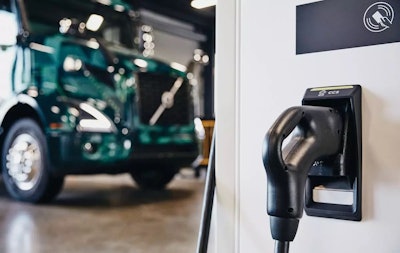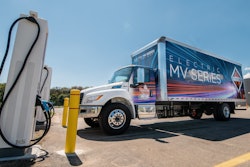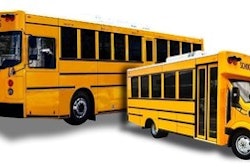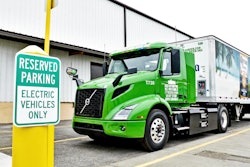
A multi-year project that brought together a range of entities to design and implement innovative programs to successfully introduce zero-emission heavy-duty battery-electric trucks and equipment into the market at scale wrapped this week, bringing widespread adoption of commercial electric vehicles closer to reality for fleets across the U.S.
The Volvo LIGHTS project, which launched in 2019 in Southern California, has mapped out a blueprint for the robust support ecosystem necessary to deploy these vehicles as fleets and the companies they serve strive for greener operations.
The project culminated in an Aug. 23 event in Ontario, California, that featured off-site tours of BEV fleet projects from the vehicles themselves to warehouse equipment, charging infrastructure, energy storage, fleet maintenance facilities and more; speaker panels spotlighting lessons learned related to BEV technology, route optimization, charging infrastructure, total cost of ownership, job training, sales and service support and more; and a display of Volvo VNR Electric trucks from project participants.
During the three-year project, which ran in California’s South Coast Air Basin, Volvo Trucks deployed its first Class 8 pilot Volvo VNR Electric trucks to fleet operators to collect real-world operating data and customer feedback ahead of announcing its commercial model in December 2020. Also during that time, Volvo Group North America collaborated with 14 public and private partners to develop programs and best practices that would help lay the foundation for the successful commercialization of battery-electric freight trucks.
“By working closely with an extraordinary group of public and private partners through the Volvo LIGHTS project, we were able to validate key processes around Class 8 battery-electric truck adoption for commercial transport segments and identify challenges that needed to be addressed for widespread market introduction,” said Volvo Trucks North America President Peter Voorhoeve.
Those processes included identifying ideal routes for electrification, creating comprehensive dealer support, developing reliable and cost-effective charging infrastructure and building technician and first-responder training programs, among other things.
To identify routes, Volvo Trucks deployed 30 Volvo VNR Electric trucks to 11 fleets to operate across their daily Southern California routes to assess factors that may impact vehicle range, including topography, ambient temperature, traffic patterns, driving styles and more. This led Volvo Trucks to introduce its route planning tool, Electric Performance Generator, which enables fleet managers to simulate real-world routes for their VNR Electric trucks.
During the project, Volvo Trucks’ largest West Coast dealership, TEC Equipment, provided uptime support to the fleet customers that leased VNR Electrics through the Volvo LIGHTS project. The hands-on experience gained during the project led TEC Equipment Fontana to become the nation’s first Volvo Trucks Certified Electric Vehicle Dealer and spurred the rollout of certified dealerships across North America.
Southern California Edison (SCE) and Shell Recharge Solutions collaborated with other project partners to install and energize 58 networked public and private charging stations, which provided insight into ways to streamline processes, shorten installation timelines and refine existing laws related to allowing entities other than utilities to re-sell electricity for EV charging. SCE also conducted a site grid system impact study to help plans for supporting a future of fully electrified goods movement.
Rio Hondo College and San Bernardino Valley College worked with Volvo Trucks to launch heavy-duty electric truck technician training programs, which produced a combined total of more than 45 graduates throughout the life of the project. The project also informed first-responder training materials that raise awareness of the high-voltage components on the Volvo VNR Electric.
"Zero-emission trucks work – as this project shows – and we need strong rules, in many states and federally, promoting them,” said Craig Segall, California Air Resources Board (CARB) deputy executive officer for mobile sources and incentives. “This project shows that this technology can serve business and deliver protections that will benefit the health of our communities that need it the most."
The project was funded by a $44.8 million award to California’s South Coast Air Quality Management District from the CARB as part of California Climate Investments, a statewide initiative that puts billions of Cap-and-Trade dollars toward reducing greenhouse gas emissions, strengthening the economy and improving both public health and the environment. South Coast AQMD also contributed $4 million from its Clean Fuels Fund. Volvo Group and its partners contributed $43 million in matching funds for a total project of $91 million.
“This project shows how important it is for public and private entities to work together to bring zero-emission technologies and infrastructure to the nation,” said Ben J. Benoit, chair of the South Coast AQMD’s governing board. “Now that the project is coming to an end, we look forward to seeing these cleaner trucks on the road and the impact they will have on air quality.”
Other partners in the five-time award-winning project, which was led by Volvo Group North America and California’s South Coast AQMD, included NFI Industries, Dependable Highway Express, Port of Long Beach, Port of Los Angeles, CALSTART, University of California, Riverside CE-CERT and Reach Out.










